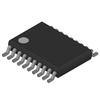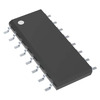Manufacturer Part Number
SN74HC574PW
Manufacturer
Texas Instruments
Introduction
The SN74HC574PW is a high-performance, universal octal D-type flip-flop with tri-state outputs. It is designed for general-purpose logic applications and provides a versatile solution for data storage and management in a wide range of electronic systems.
Product Features and Performance
Octal (8-bit) D-type flip-flop with tri-state outputs
Positive-edge triggered
Maximum clock frequency of 36 MHz
Low propagation delay of 46 ns at 6 V, 150 pF
Wide supply voltage range of 2 V to 6 V
Low quiescent current of 8 μA
Small input capacitance of 3 pF
Operating temperature range of -40°C to 85°C
Product Advantages
Versatile and widely applicable in various electronic systems
Efficient data storage and management with tri-state outputs
Reliable performance with high-speed operation and low power consumption
Compact surface-mount package for space-saving design
Key Reasons to Choose This Product
Excellent performance and reliability for critical logic applications
Cost-effective solution for high-volume projects
Trusted Texas Instruments quality and support
Quality and Safety Features
Manufactured using advanced CMOS technology for high reliability
Robust design and testing to ensure quality and safety standards
Compatibility
Compatible with a wide range of logic families, including TTL, CMOS, and LVCMOS
Can be used in a variety of digital circuit designs and applications
Application Areas
Data storage and management in various electronic systems
Interface and control logic in industrial, automotive, and consumer electronics
Microcontroller and processor-based systems
Product Lifecycle
["The SN74HC574PW is currently in the Last Time Buy phase, indicating it is being discontinued by the manufacturer.","There are several equivalent or alternative models available, such as the SN74LVC574APWR and the SN74AHC574APWR, which can be considered as replacement options.","Customers are advised to contact our website's sales team for more information about available alternatives and the product lifecycle."]

 SN74HC590ANTexas InstrumentsIC BINARY COUNTER 8-BIT 16DIP
SN74HC590ANTexas InstrumentsIC BINARY COUNTER 8-BIT 16DIP SN74HC590ADTTexas Instruments
SN74HC590ADTTexas Instruments SN74HC574ANSRTexas InstrumentsIC FF D-TYPE SNGL 8BIT 16SO
SN74HC574ANSRTexas InstrumentsIC FF D-TYPE SNGL 8BIT 16SO SN74HC574DWTexas InstrumentsIC FF D-TYPE SNGL 8BIT 20SOIC
SN74HC574DWTexas InstrumentsIC FF D-TYPE SNGL 8BIT 20SOIC SN74HC574PWRTexas InstrumentsIC FF D-TYPE SNGL 8BIT 20TSSOP
SN74HC574PWRTexas InstrumentsIC FF D-TYPE SNGL 8BIT 20TSSOP SN74HC574DBRTexas InstrumentsIC FF D-TYPE SNGL 8BIT 20SSOP
SN74HC574DBRTexas InstrumentsIC FF D-TYPE SNGL 8BIT 20SSOP SN74HC574NSRTexas InstrumentsIC FF D-TYPE SNGL 8BIT 20SO
SN74HC574NSRTexas InstrumentsIC FF D-TYPE SNGL 8BIT 20SO SN74HC574APWTexas InstrumentsIC FF D-TYPE SNGL 8BIT 20TSSOP
SN74HC574APWTexas InstrumentsIC FF D-TYPE SNGL 8BIT 20TSSOP SN74HC590ADRTexas InstrumentsIC BINARY COUNTER 8-BIT 16SOIC
SN74HC590ADRTexas InstrumentsIC BINARY COUNTER 8-BIT 16SOIC SN74HC574NTexas InstrumentsIC FF D-TYPE SNGL 8BIT 20DIP
SN74HC574NTexas InstrumentsIC FF D-TYPE SNGL 8BIT 20DIP SN74HC590ADWRTexas InstrumentsIC BINARY COUNTER 8-BIT 16SOIC
SN74HC590ADWRTexas InstrumentsIC BINARY COUNTER 8-BIT 16SOIC